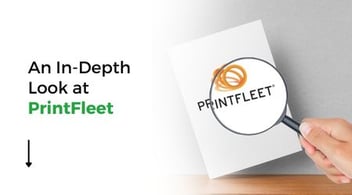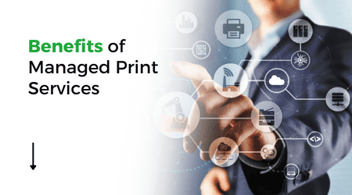Print Partner's Glossary: Key Words and Phrases in the Print Industry

The world of print management can be an overwhelming field to navigate. The jargon we use on a daily basis can be confusing to those less familiar with our industry.
If you've found yourself scratching your head reading about a keyword or phrase in print, you're certainly not alone.
At Print Partner, we work with hundreds of MSPS across the US and Canada, handling their clients' print and paying them for referrals. We get asked about industry terms by our referral partners all the time, which is why we've built this glossary for you.
Our goal is to educate and inform our referral partners.
We’ve compiled a list of our most common words and phrases to help you on your print journey. By referring to this glossary, both newbies and industry veterans will be better equipped to understand the world of print.
What are Managed Print Services? (MPS)
Managed print services are services that focus on the optimization and management of document workflow. The MPS provider will track its client’s toner levels, black & white/color ink usage, paper usage, and other metrics.
The provider pays close attention to machines with errors, such as paper jams, print slow-down, and security breaches.
The MPS provider makes recommendations to clients if machines need replacement or if more devices are needed to maximize efficiency.
MPS providers are also responsible for triaging repair requests when machines stop working.
When a device malfunctions, the client reaches out to their provider, who either offers support from its on-staff technicians or coordinates with the machine manufacturer, like Xerox or HP, to facilitate the repair.
MPS offers a way for companies to offload the burden of print onto a third-party team of experts.
What is a Managed Service Provider? (MSP)
Managed service providers (MSPs) provide IT support for their client businesses. MSPs can offer everything from network infrastructure, physical and cloud-based server management, security and desktop support services, and technical project management.
MSPs often serve as the principal technology advisors to their clients, offering support in a wide array of their clients' business activities.
MSPs may provide all of their IT functions in-house, but they sometimes partner with other companies to deliver more services.
For example, many MSPs don't manage print for their clients in-house and instead work with organizations like Print Partner to handle this service.
To read more about MSPs outsourcing print to 3rd-parties, read: MSPs: Managing Print In-House vs. Through a 3rd Party
What is a Print Device?
“Print Device” is a catch-all phrase that refers to any machine that prints.
A print device can be anything from simple desktop printers to multifunction copy machines, label printers, plotters, ticket printers, wide format printers, and large production print machines.
Nearly all businesses have print devices, but the types and quantities of devices will vary depending on the size and industry of the organization. And
What is a Print Vendor?
A print vendor is a company that sells printing equipment and print services.
First, the equipment. Print vendors will have a suite of copiers and printers they sell.
Some print vendors sell machines they manufacture (like Xerox or HP), but vendors only function as vendors and partner with large print manufacturers to sell their devices.
For example, our parent company, Green Office Partner, is a vendor that sells Xerox and HP machines.
Along with physical copiers and printers, print vendors sell MPS (managed print services). The vendor will track print usage and triage technician requests for its clients as needed.
What is a Print Manufacturer?
Print manufacturers are companies responsible for building hardware and software related to printing.
The most well-known print machine manufacturers are companies like Xerox, HP, and Canon to name a few.
Many manufacturers focus on building printing print devices and rely on their partner vendors to sell their products.
Most major manufacturers also offer repair services bundled with their equipment. For example, in the event that a Xerox print device malfunctions, Xerox will send one of its technicians onsite to make necessary repairs.
To learn about the differences between working with a print vendor and a print manufacturer service, read: Why you should work with a Print Vendor over a Print Manufacturer
What is a Multifunction Printer? (MFP)
A multifunction printer (MFP), in addition to printing, can do at least two of the three: copy, scan, and/or fax.
The functionality of MFPs varies greatly, with more complex machines capable of installing apps that allow for a wide range of options beyond simply printing.
For businesses that rely heavily on printing a large document workflow, multifunction printing is often a necessity.
What are Printer Apps?
Many of today’s more sophisticated print devices have built-in apps. Much like smartphone apps, printer apps can allow the print device’s users to perform a variety of tasks in addition to its basic printing functions.
Apps can give its users the ability to scan to SharePoint, scan directly to Quickbooks, integrate with CRM, establish security solutions that extend beyond the native capabilities of the print device, etc.
What is Xerox ConnectKey?
ConnectKey is a program that comes bundled with most of Xerox’s business-class multifunction printers.
ConnectKey has a suite of applications, such as translation and transcription features, advanced security measures, and others. It’s a defining feature of Xerox’s machines that sets them apart from competitors.
What is Print Standardization?
Print standardization is the process of aligning document workflow across multiple locations of a company. Standardization is key.
The first piece of standardization is the equipment. Are organizations using similar equipment across different locations?
The second is the service. Is one print vendor managing the entire print fleet, or does each site have a different print provider?
When multi-site clients have completely different document workflows, expenses are harder to track, and traveling employees will have greater difficulty adjusting to new offices.
For more on print standardization, read: Why Your Multi-site Clients Should Use a Single Print Vendor
What is a Print Assessment?
The print assessment is an in-depth review of a client’s print infrastructure offered by print vendors.
During a print assessment, the vendor will monitor a client’s print usage and collect invoices to understand what the client’s current print is costing them.
After the initial fact-finding, a representative from the vendor’s company will often do a walkthrough of the client’s office to get a better understanding of their environment.
Afterward, the vendor will meet with the client and get any missing information.
And finally, the vendor will make recommendations to the client for ways to save money and maximize their print efficiency. This can involve the replacement of equipment and MPS provider.
For a complete explanation of our print assessments, read: What is a Print Assessment?
What is PrintFleet?
PrintFleet is the print-tracking technology many print vendors use during their initial fact-finding for a print assessment.
Print Fleet is also known as a DCA (Data Collection Agent) or, more simply, as an “agent.”
MPS providers install PrintFleet software onto their new client’s systems to track and monitor the client’s print usage. While the tracking time period can vary, vendors typically have a good scope of their print usage after 2-4 weeks of tracking, though some industries may require longer periods.
After onboarding, print providers use PrintFleet to track current clients’ printing habits and their equipment’s performance. This information will allow the vendor to send alerts to their clients when machines are not running properly or are being overused.
PrintFleet is one of our key resources in providing a quality MPS experience.
What is a DCA? (Data Collection Agent)
The DCA is a software application installed on printing devices that tracks performance data on printing devices.
MPS providers use the DCA to track and manage clients’ printing hardware and software.
What is Total Cost of Ownership? (TCO)
Towards the end of a print assessment, MPS providers present their new client with a TCO, which will summarize all of the print-related expenses your client is currently paying for.
The TCO serves as an important baseline for your client, and in some cases, it can be an overdue wake-up call. Prior to the TCO, they may not have fully understood how much they have been paying for print.
The TCO allows the print vendor to clearly compare their proposal to their original TCO and point to the difference in costs.
The TCO offers a level of transparency for clients to examine their own print, and it makes the sales process easy when vendors can point to potential savings for them.
What is the CPP? (Cost Per Page)
The CPP refers to how much each sheet of printed paper costs the client. When comparing two different MPS providers, looking at the difference in CPP is one of the most important factors to consider.
To simplify how CPP can be calculated, take the cost of a mono toner cartridge, then divide that cost by the total number of pages that were printed until the cartridge runs out of toner.
If you pay $75 for a mono toner and the listed yield on that toner is 3,000 pages, you are paying .025 CPP.
What is a Print Click?
A click is a unit of measurement for counting the number of pages a device prints.
One side of a print page is considered one click, but printing on larger sheets of paper or printing on two sides of the same sheet can result in multiple clicks.
Print vendors track clicks to check when devices are due for maintenance. Much like how a car needs tires rotated every 5,000 or so miles, print devices need maintenance when they reach certain click amounts.
MPS providers track mono (black and white) clicks and color clicks.
What is Print Volume?
Print volume is the total amount of prints and copies a business produces. MPS providers measure print volume in units of clicks.
Print volume can be measured in days, weeks, months, quarterly, or annually. Some businesses might have very low print volume most of the year, with incredibly high print volume during a few months of the year, like accountants, as they print a forest of trees during tax time.
MPS providers track the mono-life, or the total amount of black and white clicks a device has produced in its lifetime, and color-life, or the total amount of color clicks a device has produced.
What Are the Components of a Printer?
Toner
Toner is a finely-ground plastic-based substance that is used in laserjet printers. Laserjet printers use an electrostatic charge to melt the toner particles onto the paper.
Toner comes in black, cyan, magenta, and yellow cartridges.
Ink
Ink is a tinted liquid used for printing in inkjet printers. The ink is dyed to create the colors inkjet printers use to print images onto paper.
Based on its price, you’d think that ink is made of liquid gold. In fact, according to Visually, print ink is one of the most expensive liquids on the planet!
In reality, printer ink is made up of a combination of varnish, resins, and pigments, all of which allow it to bind to a page and spread out evenly.
Fuser
Laserjet printers contain a fuser, which consists of heated rollers, to melt the toner onto the page.
Drum
The drum directs where the toner hits the page. Without the drum, there is no printed image.
Belt
Printers have a rotating belt that carries combinations of toner that get transferred onto paper to create printed images.
Tray
The tray holds a stack of paper for the printer. The amount of pages the tray holds is the printer’s tray capacity.
Learning the Basics of Print
Learning about the printing industry can be a daunting task. Luckily, we’re here to be your guide.
Never go through print alone.
Print Partner works with hundreds of MSPs throughout the country, educating you and your clients on how to get the most out of your print service.
And we’ll pay you for referrals! For each deal we close, we’ll pay the person who registers the opportunity at least $500 for the introduction and an additional $250 per $25K in revenue the deal brings us. For the MSP, we’ll pay $1,000 per 11x17 MFP sold, $100 per printer sold, and 5% recurring revenue on the client’s print allotment. And we’ll provide exceptional client service while we’re at it.
And the best part? You won’t have to deal with their printers and copiers! Leave that hassle to our print experts.
Partner with us, a Print Partner you can trust.



